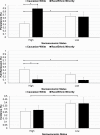Natural history of insomnia symptoms in the transition from childhood to adolescence: population rates, health disparities, and risk factors
- PMID: 32929504
- PMCID: PMC7953218
- DOI: 10.1093/sleep/zsaa187
Natural history of insomnia symptoms in the transition from childhood to adolescence: population rates, health disparities, and risk factors
Abstract
Study objectives: To determine the sociodemographic, behavioral, and clinical risk factors associated with the persistence, remission, and incidence of insomnia symptoms in the transition from childhood to adolescence.
Methods: The Penn State Child Cohort is a random, population-based sample of 700 children (5-12 years at baseline), of whom 421 were followed-up as adolescents (12-23 years at follow-up). Subjects underwent polysomnography, clinical history, physical exam, and parent- and self-reported scales at baseline and follow-up. Insomnia symptoms were defined as a parent- or self-report of difficulty falling and/or staying asleep.
Results: The 421 subjects with baseline (Mage = 8.8 years) and follow-up (Mage = 17 years) data were 53.9% male and 21.9% racial/ethnic minorities. The persistence of childhood insomnia symptoms (CIS) was 56% (95% CI = 46.5-65.4), with only 30.3% (95% CI = 21.5-39.0) fully remitting. The incidence of adolescent insomnia symptoms was 31.1% (95% CI = 25.9-36.3). Female sex, racial/ethnic minority, and low socioeconomic status as well as psychiatric/behavioral or neurological disorders, obesity, smoking, and evening chronotype were associated with a higher persistence or incidence of insomnia symptoms.
Conclusions: CIS are highly persistent, with full remission occurring in only a third of children in the transition to adolescence. Sex-, racial/ethnic-, and socioeconomic-related disparities in insomnia occur as early as childhood, while different mental/physical health and lifestyle/circadian risk factors play a key role in the chronicity of CIS versus their incidence in adolescence. CIS should not be expected to developmentally remit and should become a focus of integrated pediatric/behavioral health strategies.
Keywords: epidemiology; insomnia; longitudinal; pediatrics.
© Sleep Research Society 2020. Published by Oxford University Press on behalf of the Sleep Research Society. All rights reserved. For permissions, please e-mail journals.permissions@oup.com.
Figures

Similar articles
-
Childhood high-frequency EEG activity during sleep is associated with incident insomnia symptoms in adolescence.J Child Psychol Psychiatry. 2019 Jul;60(7):742-751. doi: 10.1111/jcpp.12945. Epub 2018 Jul 10. J Child Psychol Psychiatry. 2019. PMID: 29989664 Free PMC article.
-
Longitudinal course and outcome of chronic insomnia in Hong Kong Chinese children: a 5-year follow-up study of a community-based cohort.Sleep. 2011 Oct 1;34(10):1395-402. doi: 10.5665/SLEEP.1286. Sleep. 2011. PMID: 21966071 Free PMC article.
-
Trajectories of Insomnia Symptoms From Childhood Through Young Adulthood.Pediatrics. 2022 Mar 1;149(3):e2021053616. doi: 10.1542/peds.2021-053616. Pediatrics. 2022. PMID: 35174394 Free PMC article.
-
Childhood adversity and insomnia in adolescence.Sleep Med. 2016 May;21:12-8. doi: 10.1016/j.sleep.2016.01.011. Epub 2016 Feb 12. Sleep Med. 2016. PMID: 27448466 Free PMC article.
-
Risk factors for incident chronic insomnia: a general population prospective study.Sleep Med. 2012 Apr;13(4):346-53. doi: 10.1016/j.sleep.2011.10.033. Epub 2012 Mar 17. Sleep Med. 2012. PMID: 22425576 Free PMC article.
Cited by
-
European expert guidance on management of sleep onset insomnia and melatonin use in typically developing children.Eur J Pediatr. 2024 Jul;183(7):2955-2964. doi: 10.1007/s00431-024-05556-w. Epub 2024 Apr 16. Eur J Pediatr. 2024. PMID: 38625388 Free PMC article. Review.
-
Gender Differences in the Co-Use of Tranquilizers, Sedatives, Sleeping Pills and Alcohol among Spanish Adolescents: A Nationwide Population-Based Study.Children (Basel). 2024 Mar 13;11(3):339. doi: 10.3390/children11030339. Children (Basel). 2024. PMID: 38539374 Free PMC article.
-
Evidence of a maturational disruption in non-rapid eye movement sleep slow wave activity in youth with attention-deficit/hyperactivity, learning and internalizing disorders.Sleep Med. 2022 Feb;90:230-237. doi: 10.1016/j.sleep.2022.01.026. Epub 2022 Feb 8. Sleep Med. 2022. PMID: 35217303 Free PMC article.
-
Weighted blankets used in pediatric sleep treatment in attention-deficit/hyperactivity disorder and childhood maltreatment: where are we now and where are we going?J Clin Sleep Med. 2024 Oct 1;20(10):1563-1566. doi: 10.5664/jcsm.11304. J Clin Sleep Med. 2024. PMID: 39132690 No abstract available.
-
Association of a novel EEG metric of sleep depth/intensity with attention-deficit/hyperactivity, learning, and internalizing disorders and their pharmacotherapy in adolescence.Sleep. 2022 Mar 14;45(3):zsab287. doi: 10.1093/sleep/zsab287. Sleep. 2022. PMID: 34888687 Free PMC article.
References
-
- Ohayon MM, et al. Prevalence and patterns of problematic sleep among older adolescents. J Am Acad Child Adolesc Psychiatry. 2000;39(12):1549–1556. - PubMed
-
- Alvaro PK, et al. The direction of the relationship between symptoms of insomnia and psychiatric disorders in adolescents. J Affect Disord. 2017;207:167–174. - PubMed
-
- Gregory AM, et al. Family conflict in childhood: a predictor of later insomnia. Sleep. 2006;29(8):1063–1067. - PubMed
Publication types
MeSH terms
Grants and funding
LinkOut - more resources
Full Text Sources
Medical

